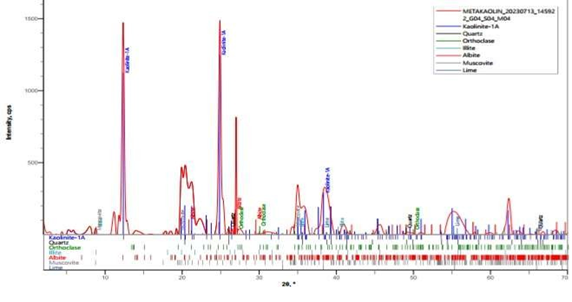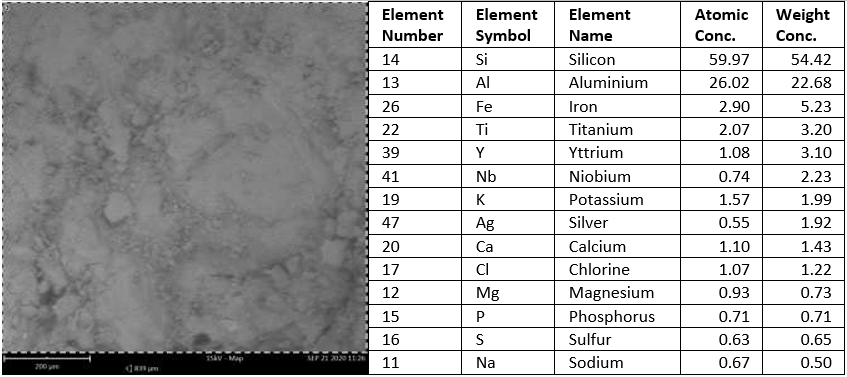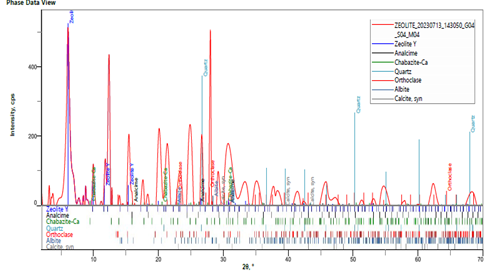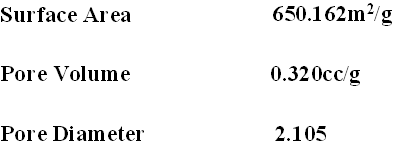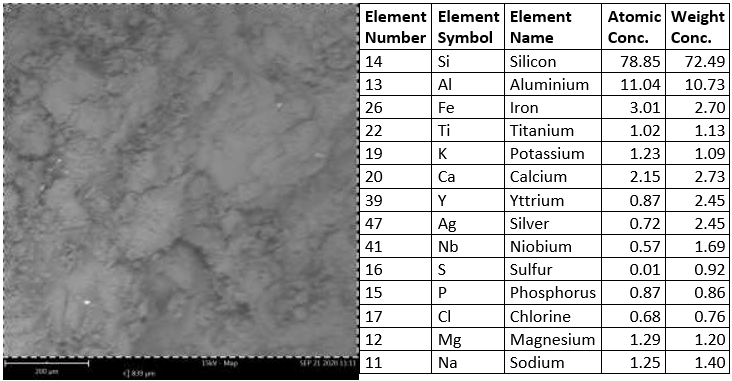Conversion of Natural Clay to Metakaolin and Zeolite Catalyst Using Hydrothermal Method
- Patrick O. Nwosibe
- Hawuwau Salami
- A. A. Ahmadu
- 182-189
- Jul 4, 2024
- Business Management
Conversion of Natural Clay to Metakaolin and Zeolite Catalyst Using Hydrothermal Method
1Patrick O. Nwosibe*, 2Hawuwau Salami, 3A. A. Ahmadu
1,2Department of Chemical Engineering, Federal Polytechnic. Kaduna
3Department of Agricultural Engineering, Taraba State University, Jalingo
*Corresponding Author
DOI : https://doi.org/10.51244/IJRSI.2024.1106014
Received: 08 June 2024; Revised: 25 June 2024; Accepted: 28 June 2024; Published: 04 July 2024
ABSTRACTS
Metakaolin is a reactive intermediate product of natural clay(kaolin) and zeolite catalysts. Metakaolin and zeolite are a very important chemical compound that finds wide applications in many chemical and petrochemical industries. This research aimed at converting natural clay (kaolin) to metakaolin and zeolite catalysts using the hydrothermal method. The natural clay was sourced from Alkareri in Bauchi State, Nigeria. The raw kaolin was first characterized (XRF, XRD) after gotten from the source. 200g of kaolin was beneficiated to reduce the particle size and remove impurities. Thereafter the beneficiated kaolin was calcinated at 850oC for 2 hours to form metakaolin. The metakaolin formed was also subjected to physiochemical analysis (XRD, XRF). Results of the XRD analysis shows that the crystalline peak at 2θ is obtained at 13.1°, 20.4°, 25 and 30.90°. 20g of metakaolin was then mixed with 15g of sodium silicate and 7.5g of NaOH to form a gel. The gel was left to age for 7 days, the crystals was washed with deionized water, and dried to get the final zeolite. The synthesized zeolite was characterized using various techniques, including X-ray diffraction and scanning electron microscopy, to elucidate its crystalline structure and morphology. The XRD results showed that the active peak achieves tailored zeolite-Y structures with enhanced catalytic properties at 2θ equals 6.09°, 12.35°, 20.04°and 30.90 BET results a show surface area of 650. 162m2/g, pore volume 0.320cc/g and pore diameter 2.105. The SEM result shows clearly the morphology of a zeolite particle typical of zeolite -Y or X. The findings contribute to the development of efficient catalysts for crucial hydrocarbon transformation processes.
Keywords: kaolin, natural clay, metakaolin, zeolite catalyst
INTRODUCTION
The production of metakaolin and subsequent conversion to zeolite from local clay, particularly kaolin, has garnered significant attention in recent years. Researchers have explored various methodologies and process parameters to effectively transform kaolin into zeolite, aiming for cost- effective and sustainable production. One important aspect of zeolite synthesis from kaolin is the alkali activation step. Several studies have investigated the use of different alkali sources, including sodium hydroxide (NaOH) and potassium hydroxide (KOH). For example, Li et al. (2018) reported successful zeolite synthesis from kaolin using NaOH as the alkali activator, achieving high crystallinity and good adsorption properties. Similarly, Zhang et al. (2020) explored the use of KOH for the activation of kaolin, resulting in the formation of zeolite with enhanced surface area and improved cation exchange capacity. The hydrothermal treatment conditions, including temperature, pressure, and duration, significantly influence the crystallization and formation of zeolite phases. Chen et al. (2017) investigated the effect of hydrothermal treatment temperature on the synthesis of zeolite from kaolin and found that higher temperatures promoted the formation of zeolite phases with improved crystallinity and surface area. Additionally, the role of reaction time during hydrothermal treatment was studied by Wang et al. (2019), who demonstrated that prolonged reaction durations favored the formation of zeolite crystals with larger particle sizes and enhanced stability. Characterization techniques play a crucial role in evaluating the quality and properties of the produced zeolite. X-ray diffraction (XRD) analysis is commonly employed to identify the crystalline phases present in the zeolite product. SEM imaging provides valuable information about the morphology, particle size, and surface characteristics of the synthesized zeolite. Nitrogen adsorption-desorption analysis, often performed using the Brunauer- Emmett-Teller (BET) method, helps determine the specific surface area and pore size distribution of the zeolite. Several studies have highlighted the potential applications of zeolite synthesized from local clay. For instance, zeolite derived from kaolin has been explored for adsorption applications, such as the removal of heavy metals from wastewater (Wang et al., 2018) and the adsorption of organic pollutants (Li et al., 2021). Additionally, the catalytic performance of kaolin- derived zeolite has been investigated in reactions such as the conversion of biomass-derived compounds (Zhang et al., 2019) and the selective oxidation of organic compounds (Xu et al., 2022).
MATERIALS AND METHOD
Materials
The following materials and reagents were used for this research; Kaolin clay from Alkareli, Bauchi State, Zinc Chloride, Sodium Silicate, Hydrochloride acid and distilled water. The materials were sourced from the school laboratory and open market.
The equipment used for the research includes weighing balance, magnetic stiller, oven, beakers, muffle furnace, measuring cylinder and grinder
METHODOLOGY
2.2 Clay Preparation
A sample of natural clay was collected from Alkareli, Bauchi State, Nigeria. The kaolin clay was cleaned to remove any impurities, such as organic matter, stones, or debris. This was achieved by washing the clay with water and allowing it to settle. The settled clay was collected and dried to remove excess moisture. Grinding the dried clay was done in a mortar to achieve a finer particle size, which aids in subsequent processing
2.3 Beneficiation
400g of kaolin clay was dissolved in 150 ml of deionized water to form a suspension which is decanted and the drifts at the bottom were discarded. The solution is allowed to settle for 3hrs and then filtered. The process is repeated 3 times then dried at room temperature for 5 days, ground and sieved to a particle size of 0.046mm
2.4 Gel formation
15g of metakaolin was mixed with 34.10g of Na2SiO3, 7.5g of NaOH,75ml of distilled water and stirred at room temperature for 7hrs at 700rpm to form a hydrogel. The gel was aged for 3 days at room temperature.
2.5 Hydrothermal Treatment
Following the alkali activation, the resulting mixture is subjected to a hydrothermal treatment. This process involves maintaining the mixture at a high temperature and pressure in an autoclave or reactor vessel. The reaction conditions during hydrothermal treatment are critical for the formation and crystallization of zeolites. The hydrothermal treatment is typically conducted at temperatures ranging from 80 to 200 degrees Celsius and pressures between 1 and 10 atmospheres. The duration of the treatment can vary from a few hours to several days, depending on the desired zeolite type and the specific reaction kinetics.
The aged hydrogel was transferred into a stainless autoclave and oven heated at 100°C for 7 hrs to form a crystal.
2.6 Filtration
The gel is filtered using filter paper to remove the excessive water.
2.7 Washing
The gel was washed with deionized water until its pH became 7.
2.8 Drying
The washed gel was oven -dried for 8 hrs at 100°C and ground to a powdered form. The final dried solid product was characterized by XRD, SEM, XRF and BET.
RESULTS AND DISCUSSIONS
3.0 Elemental composition of raw and beneficiated kaolin
The elemental composition (XRF) of Alkaleri kaolin before and after beneficiation is given in Table
3.1. It was seen that silicon and aluminum have the highest concentration with small traces of iron, calcium, vanadium, potassium and chlorine when obtained from the mining site, this is in line with what was reported by Salami et al. (2019) After the beneficiation the concentration of oxygen, and aluminum decreased by 1%, while the concentration of silicon increased by1℅.
Table 3.1: Elemental composition of raw and beneficiated Kaolin
| ELEMENTS | SYMBOLS | RAW KAOLIN | BENEFICIATEDKAOLIN |
| Oxygen | O | 49.157 | 48.919 |
| Aluminium | Al | 22.351 | 21.711 |
| Silicon | Si | 23.687 | 24.038 |
| Chlorine | Cl | 0.648 | 0.921 |
| Potassium | K | 0.046 | 0.377 |
| Iron | Fe | 0.941 | 1.178 |
| Calcium | Ca | 0.300 | 0.195 |
| Vanadium | V | 0.105 | 0.106 |
3.2 : Chemical composition of raw and beneficiated kaolin
The chemical composition of kaolin sample collected from Alkaleri and after beneficiation determined by X-ray Fluorescence is given in Table 3.2. The main compositions of the kaolin samples are oxides of Si and Al with concentrations of 50.663 and 42.23 as collected from the mining site respectively. After beneficiation, the concentration of silicon oxide increased by 1%, while the concentration of aluminum oxide decreased by 1%. This also follows the pattern reported by Attah et al (2018.)
Table 3.2: Chemical compositions of raw and beneficiated kaolin sample from Alkaleri as determined by XRF Spectrometer
| Oxide | Symbol | Raw kaolin Con. (wt%) | Beneficiated kaolin Conc. (wt℅) |
| Silicon dioxide | SiO2 | 50.673 | 51.424 |
| Aluminium oxide | Al2O3 | 42.231 | 41.021 |
| Titanium oxide | TiO2 | 3.861 | 3.397 |
| Iron (III) oxide | Fe2O3 | 1.345 | 1.685 |
Figure 3.1: XRD pattern of metakaolin
Figure 3.1 shows the XRD pattern of metakaolin, it can be seen that the crystalline structure
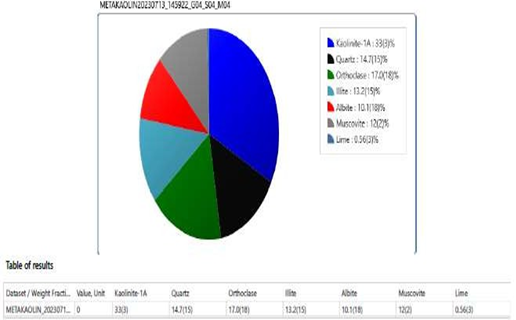
Figure 3.2: Mineralogical composition of metakaolin
From figure 3.2, the converted kaolin into metakaolin, shows kaolinite having 33%, Quartz 14.7%, Orthorclave 17.0%, Illite 13.2%, Albite 10.1%, Muscovite 12% and 0.56%. Similar trends were also reported by Yao et al (2018).
Figure 3.3: SEM image of Metakaolin
Table 3.4: Chemical composition of synthesized zeolite
| Oxide | Formula | Conc (wt%) | Mole% |
| Silicon Oxide | SiO2 | 55.371 | 66.116 |
| Aluminum Oxide | Al2O3 | 35.262 | 24.812 |
| Iron (iii) Oxide | Fe2O3 | 1.829 | 0.822 |
| Titanium Oxide | TiO2 | 4.383 | 3.937 |
The composition of zeolite was reported in percentage of oxide as shown in Table 3.4, The concentration of silicon oxide and aluminum oxide were 55.371% and 35.262% were obtained as reported by Nwosibe et al. (2019.)
Figure 3.4: XRD pattern for synthesized zeolite
From figure 3.4, the peak crystallinity at 2θ is obtained at 6.09°, 12.35°, 20.04°and 30. 90°.These trends obtained follows similar trends as reported by Salami et al, 2018.
Table 3.5: BET for the synthesized zeolite.
From Table 3.5, the synthesized zeolite has a surface area of 650.162m2/g, and a pore volume of 0.320cc/g and a pore diameter of 2.105 was reported by Alhillo et al (2015), having similar trends.
Figure 3.5: SEM image of synthesized zeolite
CONCLUSION AND RECOMMENDATIONS
In conclusion, the Kaolin was sourced from Alkaleri Bauchi State, Nigeria and characterized, the XRF result shows the presence of aluminum and silicon oxide at 42.23% and 50.6% respectively after beneficiation.
The beneficiated kaolin was successfully converted to metakaolin and later to zeolite -Y. Physiochemical analysis of the metakaolin and zeolite formed shows the result is in line with what is obtainable in literature and other similar research work done in different parts of the country and beyond.
Finally, the production of zeolite from local clay holds great potential for various industrial applications. By harnessing the natural resources available, we can unlock the benefits of zeolites while promoting sustainability and reducing reliance on imported materials.
4.2 Recommendation
From the work done, the following recommendations can be put forth
- The metakaolin and zeolite produced should can be used for catalytic activities to ascertain their effectiveness
- This should be compared with imported zeolite to see the similarities and differences
- Local production of zeolite should be encouraged to reduce importation and enhance the balance of trade in the country
ACKNOWLEDGEMENT
The team acknowledge the assistance of TETFUND, Kaduna Polytechnic office in the success of this projects
REFERENCE
- Aderemi, O., (2004). “Preliminary Studies on Synthesis of Zeolites from Local Clay,” Nig. J. Sci. Res., 4(2), pp. 7-12.
- Adefila, S., Ajayi, and Atta, Y. (2007) Synthesis of Faujasite Zeolites from Kanakara Kaolin Clay. Journal of Applied Sciences Research, 3, 1017-1021
- Ajayi, (2012) Development of Large Pore Zeolites from Kaolinite Clay. Doctoral Dissertation, Ahmadu Bello University, Zaria
- Alvira P, Tomas-Pejo E, Ballesteros M, and Negro Pretreatment technologies for an efficient bioethanol production process based on enzymatic hydrolysis: A review. Bioresource Technology. 2010; 101:4851-4861
- Aroke, U., El-Nafaty, and Osha, O. (2013) “Properties and Characterization of Kaolin Clay from Alkaleri, North-Eastern Nigeria.” International Journal of Emerging Technology and Advanced Engineering, 3, 2250-2459.
- Asselman k., Pellens N., Samba C., Martens J., and Christine E., (2022). “Super-ions of sodium actions with hydrated hydroxide anions, inorganic structure directing zeolite synthesis”. Material Horizons. 8(9):2576-2583.
- Asselman, K; Nikolaus, H; Taulelle F.; Breynaert, E. and Erick, K., (2022). “Ion-Pairs in Aluminosilicate-Alkali Synthesis in Determining the Aluminium Content and Topology of Crystallizing Zeolite”. Chemistry of Materials. 34 (16): 7150
- Bass, D.; Howe, A.; Brown, N.; Barton, H.; Demidova, M.; Michelle, H.; Li, L.; Sanders, H.; Watkinson, S. C; Willcock, S.; and Richards, T. A (2007). “Yeast forms dominate fungal diversity in the deep oceans”. Proceedings of the Royal Society B: Biological 274 (1629): 3069–3077. doi:10.1098/rspb.2007.1067. PMC 2293941. PMID 17939990.
- Chen Y, Stevens MA, Zhu Y, Holmes J, and Xu H. “Understanding of alkaline pretreatment parameters for corn stover enzymatic saccharification.” Biotechnology for Biofuels. 2013;6(8):1-10
- Cronstedt AF (1756).”Natural zeolite and minerals”. Svenska Vetenskaps Akademiens Handlingar 17: 120.
- Edomwonyi-Otu, L.C., Aderemi, B.O., Edomwonyi-Otu, O., Simo, A. and Maaza, M. (2012) “Alum Production from Some Nigerian Kaolinite Deposits”. International Journal of Engineering Research in Africa, 7, 13-19.
- Ezekiel, O., Adekunle, G., Friday, N., and Adedapo, A. (2018).” Synthesis of Zeolite Clay from Erusu Akoko Southwestern Nigeria”. Journal of Chemical Society of Nigeria, 43, 381-786.
- Georgiev, D.; Bogdanov, B.; Angelova, K.; Markovska, I.; and Hristov, Y. (2009), “Synthetic Zeolites Structure, Classification, Current Trends in Zeolite Synthesis Review”, International Science conference, Dr. Assen Zlatarov University, Stara Zagora, Bulgaria, Vol. 7, pp.1-5.3 https://byjus.com/jee/zeolites/ https://doi.org/10.4028/www.scientific.net/JERA.7.13
- Jiang L, Fang Z, Li X, Luo J, and Fan S. (2013).” Combination of dilute acid and ionic liquid pretreatments of sugarcane bagasse for glucose by enzymatic hydrolysis.” Process Biochemistry. 48:1942-1946
- Sanchez OJand Cardona CA. (2008) “Trends in biotechnological production of fuel ethanol from different feedstocks.” Bioresource Technology. 99:5270-5295
- Sudipta D., Marcos A.K., Mohuli D., Soyane J.S., Farid C., Paulo R.W., and Carlos A.M., (2021).”Hydrothermal synthesis of zeolite Y from green materials”. The Canadian Journal of Chemical Engineering, 9 https://doi.org/10.1002/cjce.23994
- Tortora, G J.; Funke, B. R.; Case R. L. (2010).” Microbiology An Introduction” (10 ed.). San Francisco, CA: Pearson Benjamin Cummings. p. 135. ISBN 978-0-321-58202-7.
- You Y, Zhou Z, Zhou P, Bu L, Jiang J, and Jang (2016).”Comparison of pretreatment methods for production of ethanol from sugarcane bagasse”. Bio Resource. 2016;11(1):2297-2307
- Y. Sun and J. Cheng, (2002). “Hydrolysis of lignocellulosic materials for ethanol production: a review,” Bioresource Technology, vol. 83, no. 1, pp. 1–11.
- Yu N, Tan L, Sun Z-Y, Nishimura H, Takei S, and Tang (2018). “Bioethanol from sugarcane bagasse”: Focused on optimum of lignin content and reduction of enzyme addition. Waste Management.;76:404-413.
- Visser EM, Falkoski DL, de Almeida MN, Maitan-Alfenas GP, and Guimaraes VM. (2013). “Production and application of an enzyme blend from Chrysoporthe cubensis and Penicillium pinophilum with potential for hydrolysis of sugarcane bagasse.” Bioresource ;144:587-594
- Wunna K, Nakasaki K, Auresenia JL, Abella LC, and Gaspillo PD. (2017).”Effect of alkali pretreatment on removal of lignin from sugarcane bagasse.” Chemical Engineering Transactions. 2017; 56:1831-1836.

